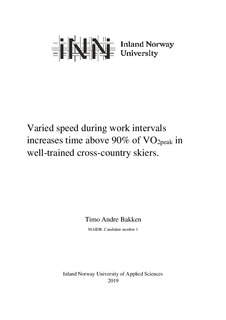Varied speed during work intervals increases time above 90% of VO2peak in well-trained cross-country skiers
Master thesis

Åpne
Permanent lenke
http://hdl.handle.net/11250/2640493Utgivelsesdato
2019Metadata
Vis full innførselSamlinger
Sammendrag
Abstract
Purpose:
Performing high-intensity interval training (HIT) sessions that optimizes physiological adaptations is important to improve performance in endurance athletes. This study compared the acute effects of two different high-intensity work interval protocols, with similar average speed and duration, on total time above 90% of peak oxygen uptake (VO2peak), mean VO2, VO2 development during the sessions and perceptual responses.
Method:
Eleven well-trained cross-country skiers performed in a randomized order 5x5 min work intervals on roller skis (double poling technique) using a varied-speed protocol (VAR) and a constant speed protocol (TRAD). Each 5 min work interval in VAR consisted of 3x40-s at 100% of maximal aerobic speed (MAS), interspersed with three 1 min blocks with a speed reduced to a workload between lactate threshold and MAS, while TRAD consisted of constant speed for 5 min throughout all work intervals.
Results:
VAR induced longer time above 90% of VO2peak compared to TRAD during all work intervals (14.9±3.8 min vs. 12.9±4.0 min, respectively). Mean VO2 was higher in VAR compared to TRAD measured as average of all work intervals during the HIT sessions (87.1±2.8 vs 85.0±2.7% VO2peak, respectively). VAR induced higher maximum session VO2 compared to TRAD (5614±392 mL∙min-1 vs. 5451±319 mL∙min-1 , respectively). Higher mean VO2-values in VAR were observed during the first 1 min 40 sec compared to TRAD. There were no differences between VAR and TRAD in mean or maximum heart rate, blood lactate concentrations or rate of perceived exertion. No differences were found between protocols in perceived musculature pain, breathing frequency or minute ventilation.
Conclusion:
Well-trained cross-country skiers sustain longer time above 90% of VO2peak and induce higher mean VO2peak using VAR compared to TRAD, indicating that work intervals where speed variations are involved might be a good strategy for HIT sessions aiming to optimize time at high percentage of VO2peak.
Beskrivelse
Mastergradsoppgave i treningsfysiologi